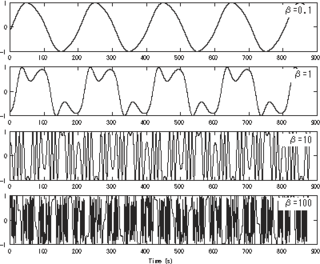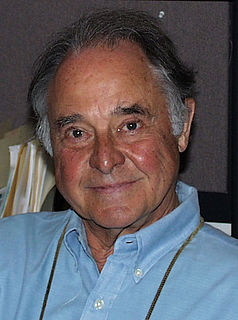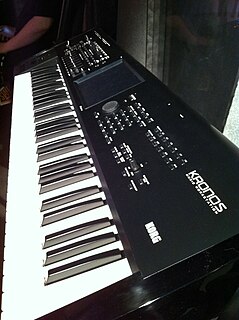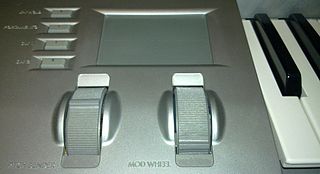Related Research Articles
Additive synthesis is a sound synthesis technique that creates timbre by adding sine waves together.

A digital synthesizer is a synthesizer that uses digital signal processing (DSP) techniques to make musical sounds. This in contrast to older analog synthesizers, which produce music using analog electronics, and samplers, which play back digital recordings of acoustic, electric, or electronic instruments. Some digital synthesizers emulate analog synthesizers; others include sampling capability in addition to digital synthesis.

An electronic musical instrument or electrophone is a musical instrument that produces sound using electronic circuitry. Such an instrument sounds by outputting an electrical, electronic or digital audio signal that ultimately is plugged into a power amplifier which drives a loudspeaker, creating the sound heard by the performer and listener.

Frequency modulation synthesis is a form of sound synthesis whereby the frequency of a waveform is changed by modulating its frequency with a modulator. The frequency of an oscillator is altered "in accordance with the amplitude of a modulating signal".
Karplus–Strong string synthesis is a method of physical modelling synthesis that loops a short waveform through a filtered delay line to simulate the sound of a hammered or plucked string or some types of percussion.

Digital music technology encompasses digital instruments, computers, electronic effects units, software, or digital audio equipment by a performer, composer, sound engineer, DJ, or record producer to produce, perform or record music. The term refers to electronic devices, instruments, computer hardware, and software used in performance, playback, recording, composition, mixing, analysis, and editing of music.
Wavetable synthesis is a sound synthesis technique used to create periodic waveforms. Often used in the production of musical tones or notes, it was first written about by Hal Chamberlin in Byte's September 1977 issue. Wolfgang Palm of Palm Products GmbH (PPG) developed it in the late 1970s and published in 1979. The technique has since been used as the primary synthesis method in synthesizers built by PPG and Waldorf Music and as an auxiliary synthesis method by Ensoniq and Access. It is currently used in hardware synthesizers from Waldorf Music and in software-based synthesizers for PCs and tablets, including apps offered by PPG and Waldorf, among others.

A digital piano is a type of electronic keyboard instrument designed to serve primarily as an alternative to the traditional acoustic piano, both in the way it feels to play and in the sound produced. Digital pianos use either synthesized emulation or recorded samples of an acoustic piano, which are sounded through an internal loudspeaker. They also incorporate weighted keys, which recreate the feel of an acoustic piano. Some digital pianos are designed to also look like an upright or grand piano. Others may be very simple, without a stand.
Digital waveguide synthesis is the synthesis of audio using a digital waveguide. Digital waveguides are efficient computational models for physical media through which acoustic waves propagate. For this reason, digital waveguides constitute a major part of most modern physical modeling synthesizers.

The Yamaha DX7 is a synthesizer manufactured by the Yamaha Corporation from 1983 to 1989. It was the first successful digital synthesizer and is one of the best-selling synthesizers in history, selling more than 200,000 units.
An analog modeling synthesizer is a synthesizer that generates the sounds of traditional analog synthesizers using DSP components and software algorithms. Analog modeling synthesizers simulate the behavior of the original electric and electronic circuitry in order to digitally replicate their tone.

John M. Chowning is an American composer, musician, discoverer, and professor best known for his work at Stanford University, the founding of CCRMA - Center for Computer Research in Music and Acoustics in 1975 and his development of the digital implementation of FM synthesis and the digital sound spatialization while there.

The Sound Blaster 16 is a series of sound cards by Creative Technology. They are add-on boards for PCs with an ISA or PCI slot.
Banded Waveguides Synthesis is a physical modeling synthesis method to simulate sounds of dispersive sounding objects, or objects with strongly inharmonic resonant frequencies efficiently. It can be used to model the sound of instruments based on elastic solids such as vibraphone and marimba bars, singing bowls and bells. It can also be used for other instruments with inharmonic partials, such as membranes or plates. For example, simulations of tabla drums and cymbals have been implemented using this method. Because banded waveguides retain the dynamics of the system, complex non-linear excitations can be implemented. The method was originally invented in 1999 by Georg Essl and Perry Cook to synthesize the sound of bowed vibraphone bars.
Gnuspeech is an extensible text-to-speech computer software package that produces artificial speech output based on real-time articulatory speech synthesis by rules. That is, it converts text strings into phonetic descriptions, aided by a pronouncing dictionary, letter-to-sound rules, and rhythm and intonation models; transforms the phonetic descriptions into parameters for a low-level articulatory speech synthesizer; uses these to drive an articulatory model of the human vocal tract producing an output suitable for the normal sound output devices used by various computer operating systems; and does this at the same or faster rate than the speech is spoken for adult speech.
David Aaron Jaffe is an American composer who has written over ninety works for orchestra, chorus, chamber ensembles, and electronics. He is best known for his use of technology as an electronic-music or computer-music composer in works such as Silicon Valley Breakdown, though his non-electronic music has also been widely performed. He is also known for his development of computer music algorithmic innovations, such as the physical modeling of plucked and bowed strings, as well as for his development of music software such as the NeXT Music Kit and the Universal Audio UAD-2/Apollo/LUNA Recording System.

The Kronos is a music workstation manufactured by Korg that combines nine different synthesizer sound engines with a sequencer, digital recorder, effects, a color touchscreen display and a keyboard. Korg's latest flagship synthesizer series at the time of its announcement, the Kronos series was announced at the winter NAMM Show in Anaheim, California in January 2011.

The Korg Z1 is a physical modelling sound synthesiser released in 1997. Touted as a polyphonic Prophecy, the Z1 implements 13 synthesis types, all derived from the original OASYS synthesizer.

The Korg OASYS PCI is a DSP-based PCI-card for PC and Mac released in 1999. It offers many synthesizer engines from sampling and substractive to FM and physical modelling. Because of its high market price and low polyphony, production was stopped in 2001. About 2000 cards were produced.
Georg Essl is an Austrian computer scientist and musician, who works in the areas of human-computer interaction, acoustics, mobile computing and mobile music. He is a visiting research professor at the College of Letters & Sciences at the University of Wisconsin–Milwaukee, and he is also affiliated with the Center for 21st Century Studies. Prior to that he was an assistant professor at the University of Michigan.
References
- Hiller, L.; Ruiz, P. (1971). "Synthesizing Musical Sounds by Solving the Wave Equation for Vibrating Objects". Journal of the Audio Engineering Society.
- Karplus, K.; Strong, A. (1983). "Digital synthesis of plucked string and drum timbres". Computer Music Journal. Computer Music Journal, Vol. 7, No. 2. 7 (2): 43–55. doi:10.2307/3680062. JSTOR 3680062.
- Julius O. Smith III (December 2010). Physical Audio Signal Processing.
- Cadoz, C.; Luciani A; Florens JL (1993). "CORDIS-ANIMA : a Modeling and Simulation System for Sound and Image Synthesis: The General Formalism". Computer Music Journal. Computer Music Journal, MIT Press 1993, Vol. 17, No. 1. 17/1 (1).